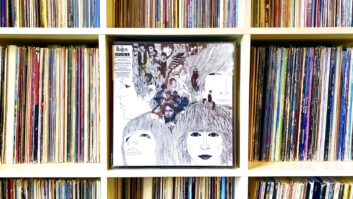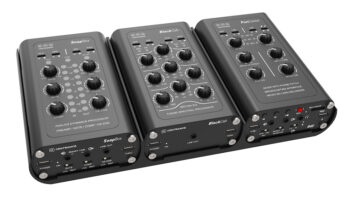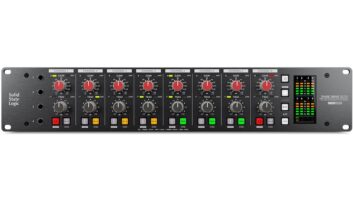RACKMOUNT CONSOLE STRIPThe Amek Pure Path Channel in a Box is a channel strip from the Amek 9098i console with a compressor section added, all in a single rackspace with built-in power supply. Designed by Rupert Neve, the Channel in a Box (CIB) is the first product in Amek’s Pure Path line of interactive, rackmounted processors.
As one might expect, the CIB offers both Line and Mic paths. However, as well as separate inputs, the Mic and Line sections also have separate output connections, and both paths can pass audio at the same time. The EQ section includes high- and low-frequency filters, two switchable-bandwidth LF and HF EQs and a 2-band, midrange parametric equalizer. Filter, EQ and dynamics sections are normally in the mic signal path, but the CIB has the unique ability to route all three sections to the mic, the line or the sidechain signal path of the compressor.
LOGICAL LAYOUTThe front panel shows, from left to right, the order in which the audio signal flows through the CIB’s processing sections. There is no way to re-order the way the processing sections are connected together, such as putting the compressor after the filter but before the equalizer. The intended design allows you to insert only the required processing sections; unneeded sections may be bypassed, thus keeping the audio path pristine as possible. Some alternate routing options would enhance the unit’s versatility.
Each section features the same trio of Alps button switches: an In/Section Bypass switch; a Line switch that flips the section from the normal Mic path to the Line path; and a Sidechain button that routes the section’s function to the sidechain input of the compressor. Switching to sidechain lifts that section from either Mic or Line paths. The sidechain feature allows you to set up any combination of shelving EQ, parametric or high/lowpass filtering, but the lack of an additional rear panel insert jack means you cannot add external processors to the sidechain.
The CIB is powered by an internal switching power supply made by Harman International and fitted with a newly updated, small and quiet cooling fan. The CIB makes use of two different analog chips: the Motorola MC33078 and the high-slew-rate Burr-Brown OPA2134, both dual-op amp packages.
MICROPHONE PREAMP SECTIONStarting at the left side of the CIB are the microphone and line input sections. The mic input circuit is called a T.L.A., or Transformer-Like Amplifier, because it behaves electrically just like a transformer by using a common mode rejection input coil. Input impedance is 5k ohms, and there is a rotary stepped gain setting control graduated in 6dB steps from 0 dB up to a whopping +72 dB. An additional mic gain trim control provides ñ6dB fine adjustment. The manual states that the mic input can accept up to +20dBu levels without using an attenuator pad (the unit has none), so the mic input could easily double as a second line input. Additional switches in this section include those for phase flip and phantom power, and there is a small LED meter to indicate input levels in either Mic or Line paths. One quirk: You can monitor the output levels of both the Line and Mic paths, but you will have to find the Source button at the other end of the front panel in the Output section. The Source button reads the level before the output trim fader and indicates the level through the unit or, if you are using the compressor, the final makeup gain level.
LINE INPUT SECTIONLine input impedance is 10 kilohms balanced, and a special floating transformer provides good low-frequency performance. A variable gain control allows for an 18dB input range, from -6 dB to +12 dB – I was unable to overload the line input, however. An internal jumper allows the Line input to be reconfigured as a balanced summing amp input, which turns the CIB into a mixing bus processor for summing balanced outputs from other Pure Path units or any other fully balanced gear in your studio.
FILTER SECTIONNext in the processing chain are the high- and lowpass filters. Both filters are switched in and out together with the In/Bypass switch and, like the rest of the sections, can be switched into either the Line path or the compressor sidechain path. Both the high- and lowpass filters are 18dB-per-octave designs with ranges of 2.5 to 25 kHz (low) and 22 to 300 Hz (high). I found these filters worked smoothly with no stridency or ring.
EQUALIZERTo the right is the 4-band equalizer. It is probably more proper to view this section as two, 2-band equalizers, because Rupert Neve considers the LF/HF as a single equalizer in series with a separate LMF/HMF EQ, a design that is familiar to Focusrite owners.
The manual erroneously depicts the HF section first in line, but the front panel confirms that the LF section is the first section of the equalizer. The LF section operates from 30 to 300 Hz, with 18 dB of boost or cut. The Peak button toggles between shelf and peak curves with a Q of 0.7. Shelving is at 12 dB per octave. The Glow button, as I determined by listening (and the manual shows graphically), broadens out the curve to end up sounding more like the bass tone control’s action on my father’s old Magnavox hi-fi. The LF section is switched between In/Bypass in tandem with the corresponding HF section. So, instead of the trio of buttons, LED’s indicate routing status of the LF and its companion HF section, which is located to the right of the LMF/HMF equalizer.
The LMF and HMF equalizer is a fully parametric design with overlapping frequency selection, adjustable Q factors of 0.7 to 2 and boost or cut of 18 dB for each section. Both sections have x5 buttons that multiply the indicated frequency settings by five. The LMF’s frequency range is 20 to 200 Hz, while the HMF’s frequency section covers 500 to 5k Hz.
Finally, the HF section’s frequency range is 2 to 20 kHz. As in the LF section, Peak toggles between bell-shaped and shelving curves, and Q is fixed at 0.7. The shelf is 12 dB per octave, and there is a Sheen button that also broadens out the curve and applies a high-end gloss reminiscent of old hi-fi tone controls.
COMPRESSORAfter the equalizer is the compressor section. All controls are continuously variable over an exceptional range. Ratio goes from 1:1 all the way to 40:1. Similarly, threshold can be set anywhere from -40 to +20 dB, while the attack control range is 0.3 to 300 ms. Release time also has a wide range, from 0.1 to 10 seconds. An “And Much More” button (marked &MM) changes the compression curve from hard to soft knee. Output or makeup gain is adjustable from -6 to +18 dB.
Normally, the compressor is in the Mic path with the mic signal presented to the sidechain input. Pushing the Line switch flips the compressor to the Line path with line signal presented to the sidechain. Pushing the Key switch re-routes the sidechain to whichever path is not selected for the compressor. All of this routing could get a little confusing, and I think Rupert Neve has done a good job of indicating what is going where through the use of lighted buttons. A Link button will link two or more CIBs together via a rear panel jack. Finally, an LED VU meter measures gain reduction only. It must have been quite a design problem to fit all of this on a single-rackspace panel, which might explain why the lighted Amek and Pure Path logos ended up on the rack ears!
OUTPUT SECTIONBoth the Mic path and Line path have their own rotary output trim faders that range from off (mute) to +10 dB, with a detented 0dB point. It seems that Neve has done a few sessions in his day, because he knows that no engineer would be happy riding level using these necessarily small knobs. So, the CIB has a rear panel facility for connecting external faders (standard 5k or 10k linear law tapers) for both the Mic and Line paths.
Finally, three overload LEDs are set to light up 4 dB before clip at the following points in the signal chain: after the mic trim (Mic O/L), after the line trim (Line O/L) and in the Sidechain. Small as these LEDs are, they offer important cues for the optimal operation of all three signal paths.
IN THE STUDIOUsing the CIB as a microphone preamp, I found it easy to get levels (LEDs gave immediate indication of overload) and enjoyed super-low noise floors and no distortion. A good preamp for Foley work, the CIB never sounded bad, even when the clip LED blinked, and the mic gain rotary switch produced no clicks or pops while stepping up and down, which allowed for gain changes on-the-fly during recording. However, I’d recommend muting the output when switching in phantom powering. And wait about ten seconds.
When using the Line path, I had to remember to push not only the In button but also the Line button. For an acid test, I ran a hot, +10dBm SMPTE timecode feed into the Line path and then used 66 dB of mic gain on a Neumann U67 microphone through the Mic path. Though so much gain nearly caused acoustic feedback, I could detect no crosstalk from one path to the other.
My first line level job for the CIB’s Line path was de-essing a prerecorded vocal track. A typical recording problem, the vocal sound was dull and lacked top end, plus the singer had a big “S” problem. First, I wound on some high frequencies with the HF section of the equalizer and then used two bands of upper midrange frequencies with the LMF/HMF section for de-essing. A little higher Q would have helped in this application, but being able to cover two different “S” frequencies put the CIB ahead of most dedicated de-essers. Another good sidechain application was a bass guitar track on which the “slaps” were too loud, especially after I got the sound up and pumping in the mix with the CIB. At first, I set the compressor to fast attack and release, which worked okay, though I got some distortion due to the fast release time on certain sustaining notes. However, by finding the center of the slap frequencies and routing them to the compressor sidechain, I was able to control them instantly and maintain a cleaner, overall tone by compressing the bass less. Because any signals in the sidechain are added to the main signal presented to the compressor, you may want to use faster attack times when using sidechain processing.
The Amek Pure Path CIB’s clever design offers a unique approach to the mic preamp/equalizer/compressor combination, and its high-quality sonic performance and overall functionality will allow you to solve a wide range of recording problems. The Amek Pure Path Channel in a Box sells for $3,250.
Thanks go to Lex Marasek and Dan Vacari at LAFX Rentals in L.A. for letting me use their studio for my evaluation. Also, thanks go to Rupert Neve, Kim Templeman-Holmes and Dave Rochester at Amek, Nashville.
The main Amek U.S. office is at 1449 Donelson Pike, Airpark Business Centre 12, Nashville, TN 37217; 615/360-0488; www.amek.com or www.purepath.co.uk.




